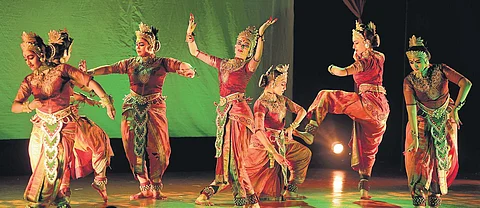

CHENNAI: With the exception of Kathakali, very few dance forms rely heavily on the face of the dancer like Bharatanatyam. Heartbreak has little to do with the hands and feet; you have the Karuna. You know the maidens are frolicking in the gardens when they do their best Hasya. And all you need is Raudra for a hero’s war cry.
But when your subject is stone and structure, and the significance they hold, you’re compelled to look beyond the Navarasas to tell your story. ‘Añjasa - Unravel the wonders of Buddhist Monuments of Asia’ does just that, redefining Bharatanatyam for the rapt audience in the process.
Second in the architecture series of Singapore’s Apsaras Arts Dance Company, Añjasa explores the beauty of Buddhist temples and the stories they carry, and offers a glimpse into the teachings of the Buddha. It begins with the story of Queen Maha Devi giving birth under a sal tree in a sacred garden that is now immortalised in the Lumbini in Nepal.
The very first act — where dancers transform themselves into horses, the chariot drawn by them, trees, butterflies and birds hovering over flowers, the flowers themselves, the gentle waves around the bathing queen — sets a lofty bar for the rest of the show. What more, the rest of the show clears it again and again.
Monuments in steps
After the Lumbini, the dancers bring to life other significant Buddhist monuments — India’s Buddhagaya and Sanchi, Vattadage of Sri Lanka, Bayon in Indonesia, Myanmar’s Shwedegon and, lastly, Borobudur in Indonesia.
Each depiction begins with a voice-over, giving you a hint of what’s to come; and each act is accompanied by an on-screen recreation of the monument, adding form to the dancers’ work. Far from audio-visual aids and the monuments in focus, it is dancers bringing stone and centuries-old art to life that will leave you awe-struck. Nowhere was it more true than the moon-stone act in the representation of the Vattadage.
The Skandakada Pahana (moon-stone) is a unique feature of Sinhalese architecture and is widely believed to symbolise the cycle of existence (Samsara in Buddhism). It’s a semi-circular stone plate worked into temple entrances. From the outside in, it has rows of swans, elephants, horses, vines and lotuses carved on it.
They are meant to depict the difference between good and bad (swans), growth (elephants), power (horses) and worldly desires (foliage). Having passed through this, one attains enlightenment at the lotus. Amid lilting strings and punctuating percussion, you get to watch the dancers make this journey with mudras and karanas.
Playing with emotions
Despite the production moving away from the traditional cushions of the dance form, it gets to play with Navarasas into two acts. Even this comes with a whole lot of ingenuity thrown in. It brings in the Bhayanaka while narrating the take of obstacles and tests on the path to Buddha’s enlightenment. But, the dancers wear demonic masks.
The demon Mara himself makes an appearance to add to the work of his minions. However, it is much later — in the story of the two brothers who received eight strands of hair from Buddha himself — that you get the tour de force of this opus.
You watch with awe as Buddha’s hairs bring rays of light to the hill, the blind begin to see, the dumb speak and all the trees of the Himalayas bear blossoms. You watch enthralled as the people spread the word of the miracles they bear witness to and get close to being part of an utopian world — all this through an exquisite series of Adbutha, Shringara and Shantha.
But my favourite part came very early in the story. Queen Maha Devi hangs on to a branch of the sal tree, poised on the verge of giving birth. The dancers gather around her, almost as if it is the sacred garden that had moved in to offer cover and protection.
As the queen goes from pain to elation with the birth of her prince, the garden around her celebrates too. Not just of the act of bringing something to life, but the beauty experienced moments before, the promise the birth holds, the prophecy it is about to fulfil and a mother’s undiluted joy over new life. Perhaps it was the surreal quality of the mythology, or just getting to watch a handful of women coming together for birth and life, this miracle of a dance act left me in tears.
It was a blessing to see Mohanapriyan Thavarajah bring exquisite form to his choreography as he joined the dancers in select acts. Given the high ideals of this production envisaged by Aravinth Kumarasamy, he hits every spot — from intrigue to familiarity — just right.
The dancers, each of them, had their own signature and managed to draw eyes even while being a part of an ensemble. Nithya Menon had my complete attention.With people around the globe still delighting in this work, five years since its debut, it is likely to come to your city again. When it does, drop everything to watch this and experience reverence in person.